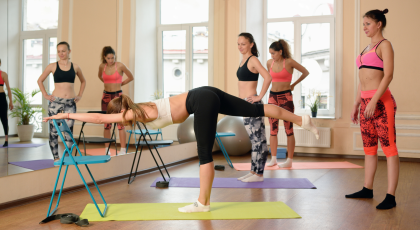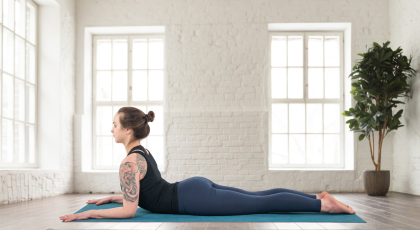View basket (0 items $0.00)
Error message
- Notice: unserialize(): Error at offset 5 of 154 bytes in variable_initialize() (line 1202 of /home/dh_6hcdc2/yogau.online/docroot/includes/bootstrap.inc).
- The file could not be created.
- The file could not be created.

Your Body's True Foundation: The Role of the Pelvic Floor in Structural Balance - An Interview with Yoga Therapist Leslie Howard
How can yoga help us retain pelvic floor health and avoid some of the common pelvic floor issues that many people struggle with? In this interview, yoga therapist Leslie Howard shares insights from her work with yoga for pelvic floor issues as well as initial results from a study on yoga for incontinence. Also check out Leslie's webinar, Surprising Truths About Pelvic Floor Disorders- And How Yoga Can Help.
Yoga U Online: On your website, you say that stabilizing, stretching, and softening the pelvic floor helps to create the correct foundation for every movement in the body. That’s a pretty bold statement! What exactly do you mean by that?
Leslie Howard: Well, the pelvic floor is really the foundation of the whole body. The pelvic floor is sitting at the bottom of our torso, so it literally forms the floor for all our organs - especially for women, because of the way women’s pelvises are designed. Women are designed to have a baby’s head come through that pelvis. So the interior outlet of the pelvis for women is actually larger than in a man. And that creates instability.
Now instability, interestingly enough, can manifest in different ways. What I found is that the prevailing belief is that if you’re female, you have a weak and loose pelvic floor. Particularly after women have children, they’re weak in the pelvic floor and may become incontinent and develop other long-term issues like prolapse, and so on.
However, in my years of teaching and studying, I have found that this is actually not necessarily always true. You can have quite the opposite problem, which can wreak just as much havoc. There are all kinds of other problems that could happen. When the pelvic floor is not working correctly, then again your foundation - your true foundation - is not supporting you in all of your movements throughout your day. It’s a strong statement, but in my experience, that’s the case.
Yoga U Online: What are some of the symptoms that could indicate a pelvic floor issue or pelvic floor weakness?
Leslie Howard: In the general population, the largest problem with a weak pelvic floor is incontinence. After that, I would say the most common problem among women is pelvic pain from too much tone in the pelvis. This is a new concept; I don’t think it’s generally accepted that women can have too much tone. I get asked by women in my workshops, “What? I can be too tight in that area?” I would say those two problems are the most common.
Yoga U Online: Issues like incontinence and prolapse become much more common as women get older, why is that?
Leslie Howard: Muscle tone all over the body lessens as we age. We lose 5% of our muscle tone with every decade of our life simply via aging. The number of babies you’ve had can contribute to it as well; it doesn’t matter whether you’ve had your children vaginally or through C-section. Studies have shown that it’s not the labor that makes the pelvic floor weak, it’s carrying the baby on the pelvic floor – especially in the third trimester.
Also, being overweight can contribute to pelvic floor problems. Posture is another huge factor, the way you sit and stand has a big impact on the long-term health of the pelvic floor. That is something I talk about a lot in my workshop. There is a correct way to sit and stand, and if you have any pelvic floor problems, you really need to pay attention to that.
You can do your exercises for 30 minutes or an hour a day, but then you’re sitting for 12 hours a day in your car, your office, at home. Many of us are sitting for hours a day, and if you’re sitting really poorly, you could do pelvic floor exercises every day for an hour, but those other 12 hours when you’re not sitting well are going to win out. It’s a numbers game.
Yoga U Online: In subtle yoga anatomy, the pelvic floor is typically associated with the root chakra, Muladhara. Imbalances in this chakra are said to cause issues around sense of security, grounding, and centering in life. Is this something that you see coming into play when people begin working with the pelvic floor? And if so, how?
Leslie Howard: You can certainly look at pelvic floor issues from the perspective of blocked prana or issues associated with the muladhara chakra. But which comes first? A tight pelvis or a feeling of insecurity in the world? We all bring karma with us. I prefer to approach my work from the view point that we all need to develop a healthy loving relationship with ourselves and the pelvis is a good place to start! If you heal your pelvis, without a doubt, you will have a more secure place in the world and be more grounded.
Yoga U Online: What is the approach to working with pelvic floor issues, which you will discuss in you upcoming course on YogaUOnline?
Leslie Howard: I use a multi-pronged, holistic approach when I work with people for their pelvic floor issues. You can’t do just one thing to fix a problem. It’s not an easy fix. You have to look at the whole picture.
Yoga U Online: What does yoga have to offer for pelvic floor health? What is it that you feel makes yoga a useful tool in this respect?
Leslie Howard: Again, it’s not one thing, it’s not a quick fix. I recieved a call from a major medical foundation, and they said, “We’ve heard about your work, and we were wondering if you could give us a list of poses that work for the pelvic floor.” And I replied, “It doesn’t work that way. I can’t just give you a list of poses; it’s what you’re doing in the poses.”
It’s cultivating awareness that is healing. The comments I hear the most in my workshops from people who are trying to find their own pelvic floor muscles is, “This is so subtle. This is so subtle.” But yet, as you start to get more aware of it, you realize it’s not so subtle. And you start saying to yourself, “How come I never noticed this before?”
So that’s number one. It’s not just a pose. It’s how you’re doing the pose, and where your awareness is in the pose. Some poses are more conducive to finding the pelvic floor than others.
Number two, “What does yoga offer to the pelvic floor?” It’s the mind-body connection, the breathing. Another thing I see all the time in people with pelvic floor problems is that they are not breathing well. They’re chest breathers, and they’re not breathing into their abdomens. It’s not that chest breathing is wrong, per se, but diaphragmatic breath has been shown again and again to be the most efficient way to breathe. You get the most oxygen, the most benefits, if you breathe into your abdomen.
And that goes back to our cultural messaging of how women today are told that their belly should be flat and hard. I’m not saying not to tone and exercise, but the abdominal exercises taught at the gym involve doing tons of crunches. Abdominal muscle toning, if not taught mindfully, can actually cause a prolapse or incontinence.
If you’re not even aware that you have a pelvic floor and you’re obsessed with getting a flat belly, you’re putting all this intra-abdominal pressure down into your pelvic floor. And if you have a weakness there, then you’re going to get pushed to the limit. That’s another thing to keep in mind when doing abdominal exercises – do them in a particular way so that you’re not putting too much pressure on your pelvic floor.
Yoga U Online: What experiences have you had working with women with various pelvic floor problems? Did you see women recover from incontinence or at least improve from a prolapse
Leslie Howard: Absolutely. A lot of women come to my workshops just for general knowledge, which is great. But a lot of women come because they’ve been struggling with one of the issues we’ve talked about and have not been so happy with the medical community. Kegel exercises are still the most recommended, or really the only recommended exercise for women if there’s a problem. It’s like a catch-all. If you have a problem there, the doctors say, “Do your Kegel exercises.”
So when they come to me, we take time with the muscles, we talk about it and we dissect it a little bit more. I’ve gotten emails from women that said that they were looking at this newer surgery called bladder pinning where they literally take a prolapsed bladder and tie it up with a mesh sling. I’ve had a couple women looking at that, and then they wrote me after my workshop and said their doctors couldn’t believe how much they had improved their condition. They were able to lift their bladder back up with toning exercises.
I’ve had a lot of women who had pelvic pain and said my workshop was transformative. They didn’t realize that, number one, a too-toned pelvic floor might’ve been the problem. And number two, they didn’t know how to address it. Again, as a culture, we want to do something. If something’s wrong, we want to do something. And a lot of times, actually, we need to undo something. We hear that principle in yoga all the time. Yoga is all about slowing down and not pushing so hard and cultivating subtlety.
Yoga U Online: Lastly, Leslie, tell us a few things about your upcoming online course.
Leslie Howard: In the course, I will discuss common pelvic floor disorders for both men and women, and what yoga can offer to help prevent them. We will cover the role the pelvic muscles play as part of the body's core stabilization system with the transverse abdominus and the multifidus muscles. We will also distinguish between overly tight and weak pelvic floors and how to address them, and why it's about much more than Kegels. As we age, more and more issues arise with the pelvic floor, and I want to help men and women know if they are predisposed to having these issues.
Yoga U Online: Does the course have videos for the different types of issues that people have?
Leslie Howard: Yes, there will be two yoga practice videos- one for hypertonic pelvic floor muscles and one for hypotonic pelvic floor mustcles. They will demonstrate how to target and tone the pelvic floor muscles in a balanced and holistic way, depending on if your pelvic floor muscles are too tight or too loose.
Yoga U Online: Thank you so much for your time and this wonderful knowledge you have accumulated.
Leslie Howard: Thank you, I really look forward to connecting with your students.
Featured Courses









